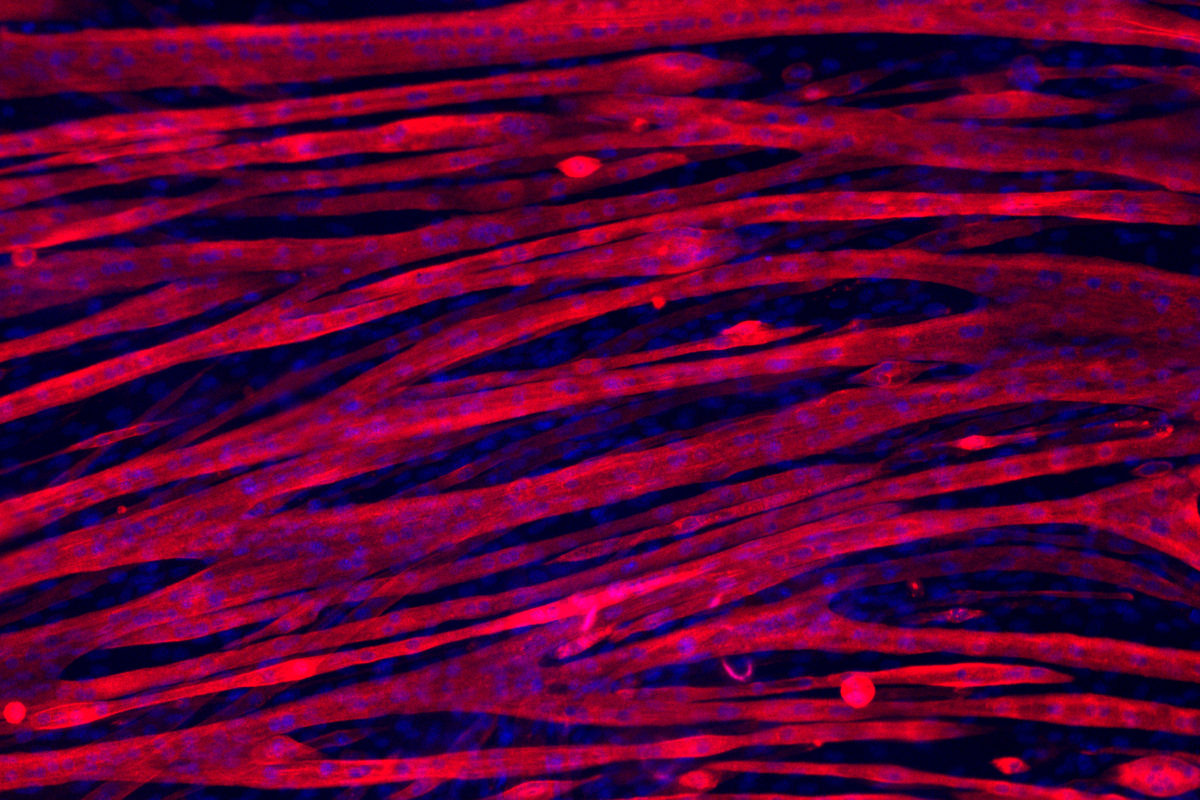
USC researcher Megan L. McCain and colleagues have devised a way to develop bigger, stronger muscle fibers. But instead of popping up on the bicep of a bodybuilder, these muscles grow on a tiny scaffold or “chip” molded from a type of water-logged gel made from gelatin.
First authors Archana Bettadapur and Gio C. Suh describe these muscles-on-a-chip in a new study published in Scientific Reports.
During normal embryonic development, skeletal muscles form when cells called myoblasts fuse to form muscle fibers, known as myotubes.
In past experiments, mouse myotubes have detached or delaminated from protein-coated plastic scaffolds after approximately one week and failed to thrive.
In this experiment, the researchers fabricated a gel scaffold from gelatin, a derivative of the naturally occurring muscle protein collagen, and achieved much better results. After three weeks, many of the mouse myotubes were still adhering to these gelatin chips, and they were longer, wider and more developed as a result.
The researchers anticipate that human myotubes would thrive equally well on gelatin chips. These new and improved “muscles-on-a-chip” could then be used to study human muscle development and disease, as well as provide a relevant testing ground for new potential drugs.
“Disease and disorders involving skeletal muscle—ranging from severe muscular dystrophies to the gradual decrease in muscle mass with aging—dramatically reduce the quality of life for millions of people,” said McCain, assistant professor of biomedical engineering at the USC Viterbi School of Engineering, and stem cell biology and regenerative medicine at the Keck School of Medicine of USC. “By creating an inexpensive and accessible platform for studying skeletal muscle in the laboratory, we hope to enable research that will usher in new treatments for these patients.”
McCain is already putting the gelatin chips into action as the winner of an Eli and Edythe Broad Innovation Awards in Stem Cell Biology and Regenerative Medicine at USC. The award provides $120,000 to McCain and her two collaborators: Justin Ichida, assistant professor of stem cell biology and regenerative medicine; and Dion Dickman, assistant professor of biological sciences at the USC Dornsife College of Letters, Arts and Sciences. In their project, they will use the gelatin chips for studying amyotrophic lateral sclerosis (ALS), or Lou Gehrig’s disease, which damages the intersections between motor nerve cells and muscle cells, called neuromuscular junctions (NMJs). McCain, Ichida and Dickman will use skin or blood cells from patients with ALS to generate and study NMJs on gelatin chips.
For the study published in Scientific Reports, additional co-authors include Nicholas A. Geisse from Oxford Instruments Asylum Research in Santa Barbara, and Evelyn R. Wang, Clara Hua, Alyssa A. Viscio, Holly A. Huber, Joon Young Kim, and Julie B. Strickland from USC.
The research was supported by the USC Viterbi School of Engineering, The Broad Foundation, the USC Undergraduate Research Associates Program, USC Women in Science and Engineering, a USC Provost’s Undergraduate Research Fellowship and a Keck School of Medicine of USC Summer Research Fellowship.
